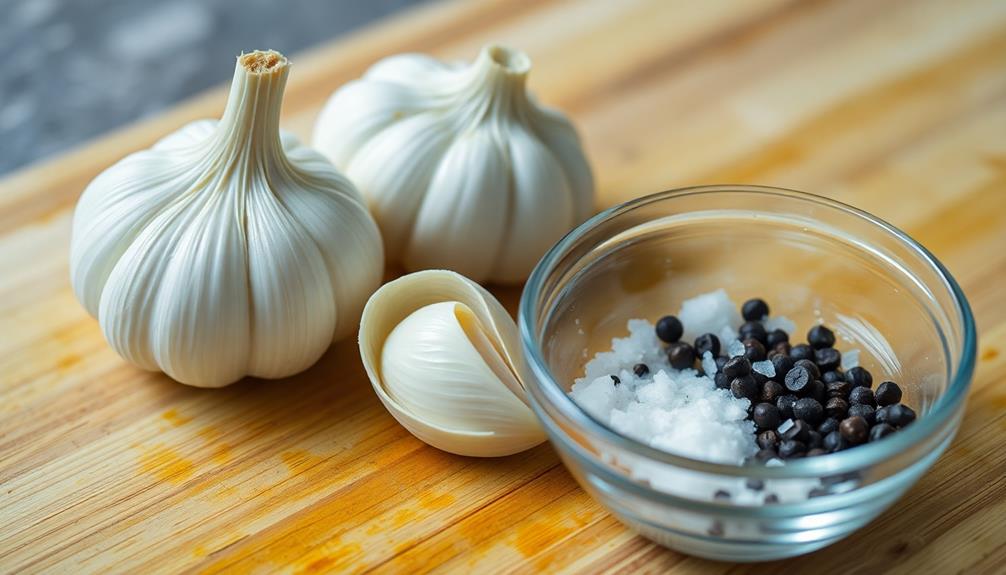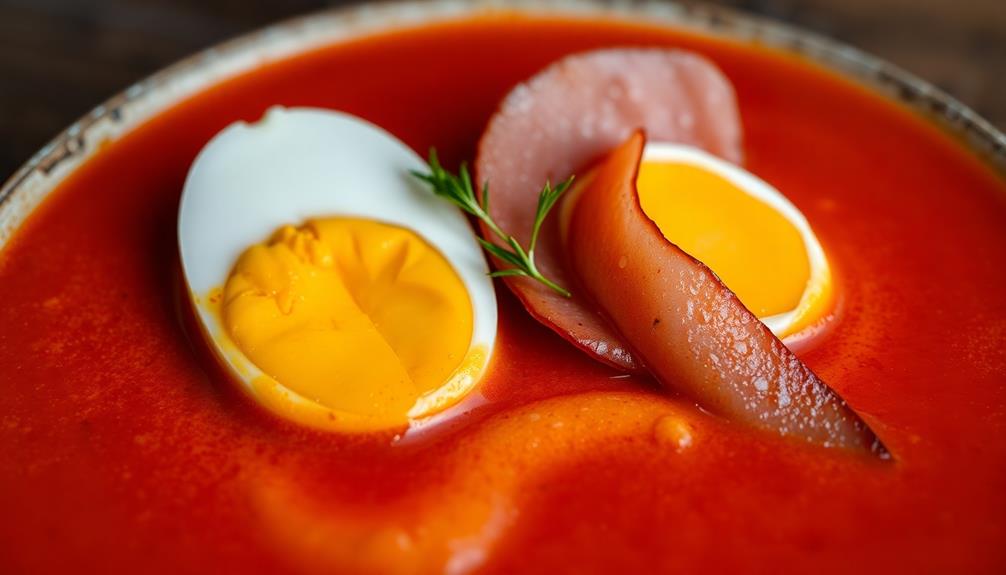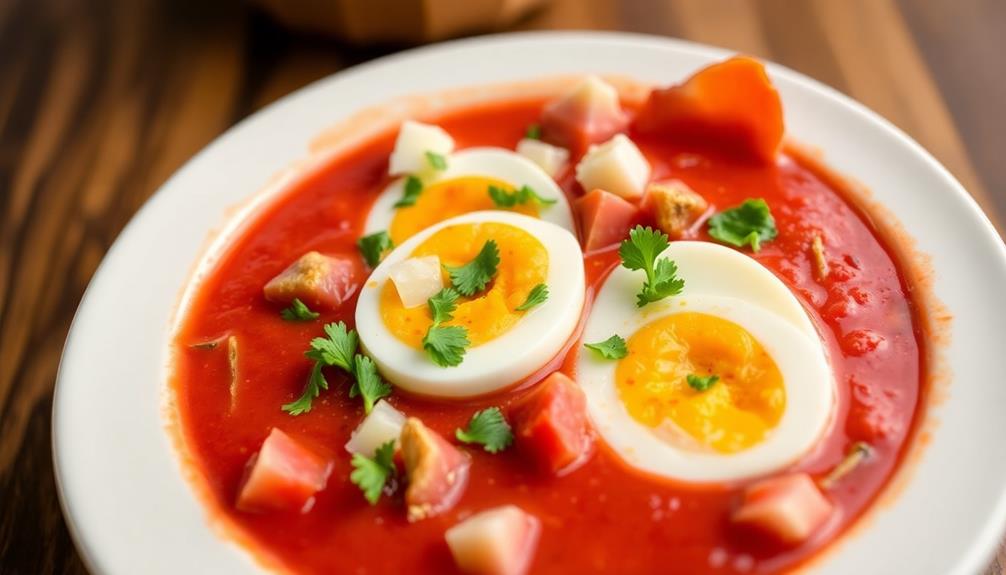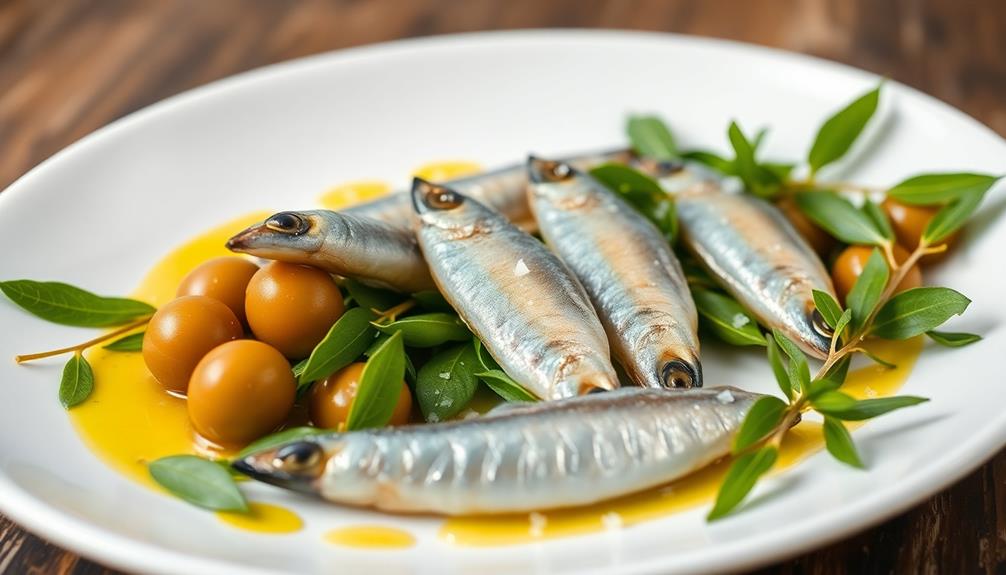Salmorejo is a vibrant, cold Spanish soup hailing from the Andalusia region. You'll blend ripe tomatoes, stale bread, olive oil, garlic, and sherry vinegar into a creamy, refreshing delight. Start by blending the base ingredients until smooth, then season with garlic, salt, and pepper. Chill the mixture for at least 30 minutes to let the flavors meld and texture thicken. Garnish with hard-boiled eggs, Serrano ham, and a drizzle of olive oil. Dive into this authentic taste of Spain, a perfect way to cool off on a warm day.
Key Takeaways
- Salmorejo is a traditional cold Spanish soup originating from the Andalusia region, made primarily from ripe tomatoes, stale bread, olive oil, and garlic.
- The name "salmorejo" refers to the brine used for preserving meats, reflecting the dish's connection to Spanish culinary heritage.
- The soup is known for its creamy texture, achieved by blending the tomatoes and bread, and is often served chilled as a refreshing summer dish.
- Proper blending and seasoning with salt, pepper, and garlic are crucial to creating a well-balanced flavor profile in salmorejo.
- Common garnishes for salmorejo include hard-boiled eggs, Serrano ham, and a drizzle of olive oil, adding layers of texture and flavor.
History
Salmorejo, a beloved Spanish dish, traces its roots back to the Andalusia region of the country. This chilled tomato-based soup has been a summertime staple for centuries, evolving from its humble beginnings as a simple refreshment for farmers and laborers.
The name "salmorejo" is believed to have originated from the Spanish word "salmorra," which refers to the brine used to preserve meats and fish. Over time, the dish transitioned from a basic mixture of bread, vinegar, and olive oil to the creamy, flavorful soup we know today.
Traditionally, salmorejo is made by blending together ripe tomatoes, garlic, bread, and olive oil until smooth and velvety. The addition of hard-boiled eggs and serrano ham on top adds a delightful contrast of textures and flavors.
Served chilled, this refreshing dish is perfect for hot summer days, capturing the essence of Andalusian cuisine.
Recipe
Salmorejo is a cold, creamy Spanish soup that originated in the Andalusia region. It's a simple yet flavorful dish made primarily from tomatoes, bread, and olive oil. The traditional method of preparation involves blending all the ingredients into a smooth, velvety consistency, resulting in a refreshing and satisfying soup.
One of the key aspects of salmorejo is the use of high-quality, ripe tomatoes. The tomatoes provide the soup with its vibrant color and distinct tomato flavor. Additionally, the inclusion of stale bread helps to thicken the soup and create a creamy texture.
Ingredients:
- 2 lbs ripe tomatoes, cored and chopped
- 2 cups stale white bread, crusts removed and torn into pieces
- 1/2 cup extra-virgin olive oil
- 2 garlic cloves, minced
- 1 tablespoon sherry vinegar
- 1 teaspoon salt
- 1/2 teaspoon ground black pepper
To prepare the salmorejo, simply combine all the ingredients in a blender or food processor and blend until smooth and creamy. Adjust the seasoning to taste, if necessary.
For best results, chill the soup for at least 2 hours before serving to allow the flavors to meld.
When serving the salmorejo, consider garnishing it with finely chopped hard-boiled egg, diced Serrano ham, or freshly chopped parsley. The contrast of the cool, velvety soup with the crunchy, salty toppings creates a delightful sensory experience.
Enjoy this refreshing and authentic Spanish dish on a warm summer day.
Cooking Steps
Begin by blending the ripe tomatoes, crusty bread, and rich olive oil until smooth.
Next, add the fragrant garlic and season the mixture to your taste.
Step 1. Blend Tomatoes, Bread, and Olive Oil

Next, create a tomato-bread-oil fusion by blending together your ripe tomatoes, stale bread, and high-quality olive oil in a food processor or blender.
Start by chopping the tomatoes into large chunks and adding them to the blender. A proper diet is essential for maintaining health and energy levels, just as a balanced mix of ingredients is crucial for a great dish, so consider the benefits of fresh produce in your meals proper diet for pets.
Then, tear the bread into smaller pieces and add it to the blender as well. Finally, drizzle in the olive oil and blend the mixture on high speed until it reaches a smooth, creamy consistency.
Be careful not to over-blend, as you want to maintain a slightly chunky texture. Once blended, your salmorejo base is ready.
The tomatoes provide the signature vibrant color and juicy tang, while the bread lends a creamy, velvety mouthfeel, and the olive oil contributes a rich, fruity flavor.
This simple yet flavorful blend is the foundation for the classic Spanish chilled soup, so make sure to blend it well.
Step 2. Add Garlic and Season to Taste

With the tomato-bread-oil base now prepared, go ahead and add in a couple of garlic cloves. Finely mince the garlic and stir it right into the blended mixture. The garlic will add a zesty, aromatic kick to the salmorejo.
Next, it's time to season the soup to taste. Start by adding a pinch or two of salt and giving it a good stir. Taste the salmorejo and add more salt if needed, adjusting to your preference.
You can also sprinkle in a bit of black pepper for an extra flavor boost.
If the soup seems too thick, thin it out by adding a splash or two of water. Conversely, if it's too thin, let it sit for a few minutes to thicken up.
Keep tasting and adjusting the seasonings until the flavors are perfectly balanced. With the garlic added and the seasoning perfected, your salmorejo is ready to serve and enjoy!
Step 3. Chill the Blended Mixture

Once you've seasoned the salmorejo to your liking, go ahead and chill the blended mixture in the refrigerator for at least 30 minutes. This step is crucial to allow the flavors to meld and the texture to thicken.
Chilling the salmorejo will help it develop a rich, velvety consistency that's perfect for serving. During this time, the garlic, tomatoes, and bread will continue to blend seamlessly, creating a harmonious flavor profile.
The cold temperature also enhances the refreshing quality of the dish, making it an ideal choice for hot summer days. Be sure to cover the container to prevent any unwanted aromas or flavors from seeping in.
Once the 30 minutes are up, give the salmorejo a quick stir to ensure even chilling. At this point, the mixture should have a thick, creamy texture, ready to be ladled into bowls and topped with your desired garnishes.
Enjoy this classic Spanish cold soup in all its chilled, flavorful glory!
Step 4. Garnish With Boiled Egg and Ham

After chilling the salmorejo, go ahead and prepare the classic garnishes.
Start by boiling a couple of eggs until they're perfectly hard-boiled. Once cooled, peel the eggs and slice them in half lengthwise. Arrange the boiled egg halves around the edges of your serving bowl or plate.
Next, grab some serrano ham or prosciutto and tear it into bite-sized pieces. Sprinkle the ham pieces over the top of the chilled salmorejo. The salty, savory ham complements the creamy, tangy soup beautifully.
You can also add a drizzle of good quality olive oil and a sprinkle of paprika for a final flourish. The vibrant red pepper powder adds a pop of color and subtle heat.
Serve the salmorejo immediately, allowing your guests to dig in and enjoy the delightful textures and flavors. The boiled egg and ham make this Andalusian classic even more satisfying.
Step 5. Serve Chilled With Desired Garnishes

After chilling the salmorejo, you're ready to serve it with the classic garnishes. The traditional toppings are boiled egg and diced Serrano ham.
Slice a hard-boiled egg in half and arrange the pieces on top of the chilled soup. Dice some Serrano ham and sprinkle it over the egg. You can also garnish with chopped parsley or chives for a pop of color and freshness.
Salmorejo is typically served in small bowls or cups, making it a perfect starter or light lunch. The combination of the cold, creamy soup and the savory toppings is incredibly refreshing, especially on a hot day.
Don't be afraid to get creative with your garnishes, too. A drizzle of high-quality olive oil or a sprinkle of toasted breadcrumbs can also add texture and flavor.
Serve the salmorejo immediately after garnishing, and enjoy the perfect balance of flavors and temperatures.
Final Thoughts
Salmorejo, a beloved Spanish dish, has undoubtedly captured the hearts and palates of many. As you've learned, this chilled, creamy concoction is a true delight, blending ripe tomatoes, crusty bread, and a hint of garlic into a smooth, refreshing experience. If you’re a fan of Salmorejo, you may also enjoy exploring other traditional Spanish dishes. One example is the traditional Basque marmitako recipe, a hearty tuna and potato stew that is bursting with bold flavors. Whether you’re a culinary adventurer or simply looking to expand your palate, Spanish cuisine has a wide array of dishes to explore and savor.
Whether served as a starter or a light main course, salmorejo is a versatile option that can be customized to your liking.
Don't be afraid to experiment with different garnishes and add-ins. A sprinkle of diced Serrano ham or boiled egg can add a delightful textural contrast, while a drizzle of fragrant olive oil or sherry vinegar can elevate the flavors.
The possibilities are endless, so have fun and make this dish your own.
As you savor each spoonful, let the flavors transport you to the sunny plazas of Spain. Salmorejo is more than just a dish – it's a celebration of the vibrant culinary heritage that makes Spanish cuisine so beloved around the world.
Frequently Asked Questions
What Is the Traditional Serving Style of Salmorejo?
You typically serve this dish chilled, often garnishing it with hard-boiled eggs, Serrano ham, and a drizzle of high-quality olive oil. The traditional serving style emphasizes the refreshing nature of this creamy, tomato-based soup.
Can Salmorejo Be Made in Advance?
You can definitely make this dish in advance. The flavors will meld together nicely, and it'll be even more delicious when you're ready to serve it. Just be sure to store it properly in the fridge until then.
How Long Does Salmorejo Typically Stay Fresh?
Typically, the dish stays fresh for 3-4 days when stored properly in the refrigerator. You can make it in advance, but it's best enjoyed within a few days for optimal flavor and texture.
Is Salmorejo a Gluten-Free Dish?
Yes, salmorejo is typically a gluten-free dish. The main ingredients are tomatoes, bread, garlic, olive oil, and vinegar – none of which contain gluten. You can enjoy this classic Spanish cold soup without worrying about gluten.
Can Salmorejo Be Frozen for Later Use?
You can absolutely freeze salmorejo for later use. The thick, creamy soup-like dish freezes remarkably well, retaining its texture and flavor. Just thaw it in the fridge before serving, and you'll have a delightful meal on hand whenever you need it.









